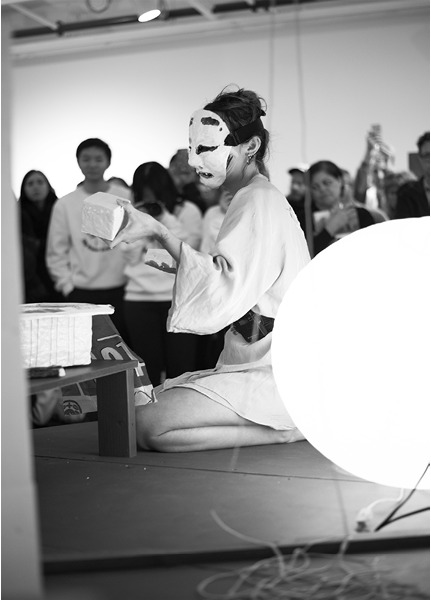
HEARTMTNDEMON: MOURNING RITUAL
first performed on December 15, 2018
205 Hudson Gallery, New York, NY
performed twice in 2018
ALISON KIZU-BLAIR
New York, NY
265323755k265323755i265323755z265323755u265323755m265323755a265323755g265323755a265323755z265323755i265323755n265323755e265323755@265323755g265323755m265323755a265323755i265323755l265323755.265323755c265323755o265323755m
vimeo.com/alisonkizublair
HEARTMTNDEMON: MOURNING RITUAL
ALISON KIZU-BLAIR
“HEARTMTNDEMON: Mourning Ritual” is the culmination of multiple performances that I have made over the past few years that speak about my Japanese American family’s internment in the United States during World War II, and investigate how I live with the ripple effects of this trauma in my daily life. In this work, I use tropes of Orientalism and images of grotesque femininity to deconstruct racial and gender stereotypes that I have experienced and internalized.
The performance is structured in three parts, and set on a circular stage that is separated into thirds by screens and curtains. As the spoken word narration unfolds, I traverse the stage, moving from the bathroom, to the kitchen, and finally to the bedroom. Using a mixture of live recitation (written in a couplet rhyme scheme), voiceover, music, and three different projected videos, I complicate the perspective of the narrator and the nature of recollection. It begins with my character waking up on the floor of her bathroom with a brutal hangover after a night of being “ghosted.” As she ruminates on the horrors of the past night, horrors of the internment creep into the text:
“Executive order 9066
Made up by a bunch of cis dicks
What was the problem they thought it would fix?
What a serious load of ‘thick as a brick’ bullshit”
As “HEARTMTNDEMON: Mourning Ritual” unfolds, I transform from a hungover, guilt-ridden woman, into a Noh actor, and finally become a Kabuki ghost who addresses the audience with a haunting call to action. The dimensionality of the stage coaxes the viewer to move locations as I move, or miss out on some of the action. Using video projection and simultaneous live action, this performance misdirects the viewer in order to remind them of the power of choice. In this work, I choose to focus on the Japanese half of my ancestry, in an attempt to reconcile my specific American hybridity and what it means to feel other.
Can we resolve horrors of the past with the horrors of today, especially when they seem to be replaying in the contemporary political and cultural climate?